
They help with auctions, team up with the community and now teach elementary schoolers about maps and measuring. This semester, Albion’s AmeriCorps added another youth program to its roster: Albion Brain Corps.
According to the college webpage, Brain Corps aims to “help students build confidence, develop a growth mindset and see how math connects to everyday life.”
Emily Brooks, alumna ‘25 and a member of Brain Corps, said the program gives students a chance to learn math unconventionally.
Filling Gaps in Learning
According to Director of Albion College’s AmeriCorps program Lindsey Knowlden, Brain Corps grew out of conversations with community partner Harry Bonner Jr. at Harrington Elementary. Those discussions were followed by a year of research and development by Brain Corps members to lay the program’s foundation.
“They volunteered in classrooms of different age groups and spent half their time developing Brain Corps,” Knowlden said.
Knowlden added that “We read articles, analyzed existing models and built something from scratch.”
Brooks said that Brain Corps addresses a “really big gap” in grade-level math proficiency at Harrington Elementary.
“There’s a lot of different gaps if you don’t know math,” Brooks said.
The program, according to Brooks, invites small groups of students to explore topics such as measurement, direction and mapping – all through interactive play.
“They were learning how to use a ruler, how to know north from south – the little things, like ‘Never Eat Soggy Waffles,’” Brooks said. “They seem to really, really like it and have a good time with it.”
Saranac senior and fellow Brain Corps member Megan Chipman said the hands-on format makes a noticeable difference in how students engage with math.
“Math was always boring for me, too,” Chipman said. “When they’re asked to just sit still all day, that’s not going to help them at all. Even doing something like running back and forth to solve a math problem keeps them engaged way more than a worksheet ever could.”
Behind the Scenes, Beyond the Classroom
Coordinating Brain Corps involves more than lesson plans. For Knowlden, one of the biggest logistical challenges has been scheduling sessions that fit both the volunteers’ and students’ availability.
Brooks, who is student teaching this semester, said the most challenging part of Brain Corps has been designing a curriculum that anyone could reuse in future years.
“They want to be able to use the stuff we’re doing now for future classes,” Brooks said. “I have to go in and make sure someone else could walk in and say, ‘I know how to do that.’”
Chipman said that the Brain Corps team has split into smaller groups focusing on curriculum development, team culture and behavioral norms to strengthen the program’s foundation.
“We don’t always think about how the team itself functions,” Chipman said. “But knowing each other’s strengths, like who’s good when a student acts out, really helps us work together.”
Ortonville sophomore Brittany Swift, who serves on the curriculum team, said the next unit will focus on money.
“We’re creating a ‘micro society’ where students form teams, develop small business ideas and learn how to make a product, calculate costs and determine profits,” Swift said. “On the last day, they’ll run their little stores. It’s a fun way to teach real-world math, like adding decimals and counting money.”
While still in its early stages, Brooks said there are possibilities to expand both Brain Corps’ curriculum and its reach.
“Next semester, I think they’re looking at doing something with English Language Arts, because Harrington’s scores in reading and writing are even lower than in math,” Brooks said.
The hope, Brooks added, is to include more students in the program’s future iterations, especially since the program currently accepts “only 10 to 12 kids.”
Changing Setting, Mindsets
One distinctive feature of Brain Corps is its location – sessions are held on Albion College’s campus rather than at Harrington Elementary, according to Brooks.
“I thought it was a great idea to have it outside of the school,” Brooks said. “Sometimes kids are stuck in a certain mindset at school, but bringing them here makes it feel fresh.”
Looking ahead, Swift said the team is looking for ways to integrate literacy.
“When we first met the kids, we gave them an ‘About Me’ worksheet,” Swift said. “Not many of them could read it, and a lot of handwriting was illegible. So we wanted a name like Brain Corps that could later work for English or other subjects.”
Ultimately, Brooks said Brain Corps is “a really great addition to the community.”
“Math opens up a lot of different things throughout the rest of your life,” Brooks said.

Leave a Reply